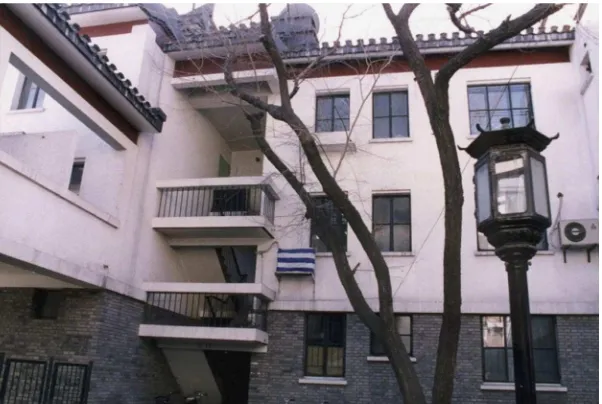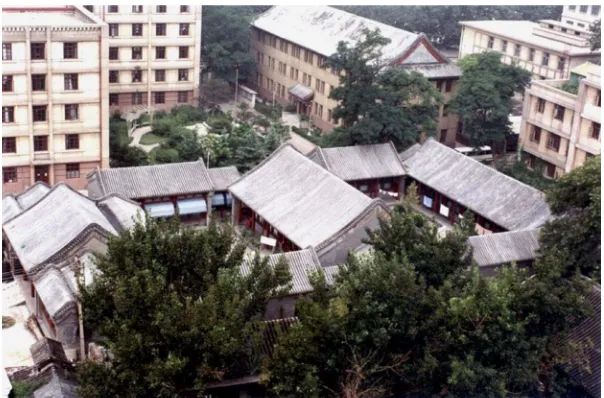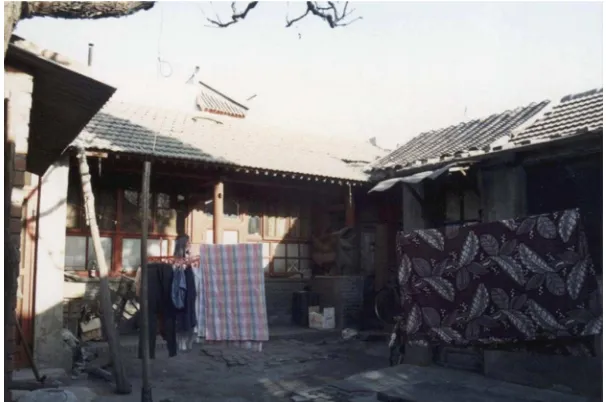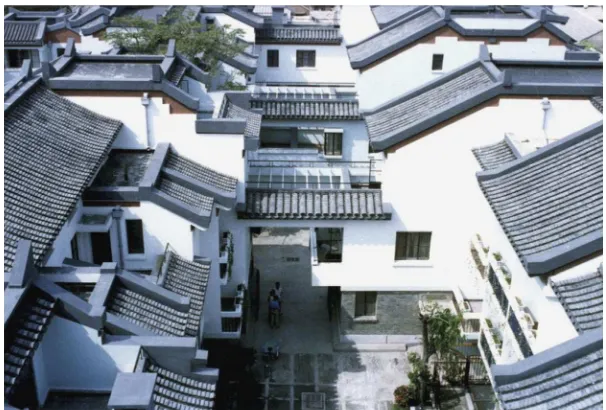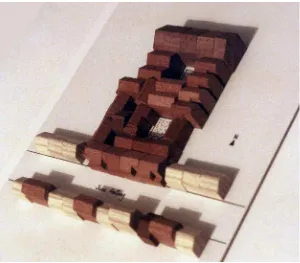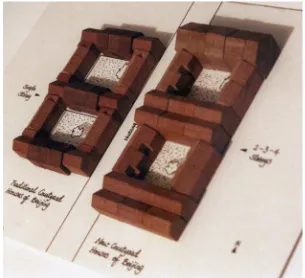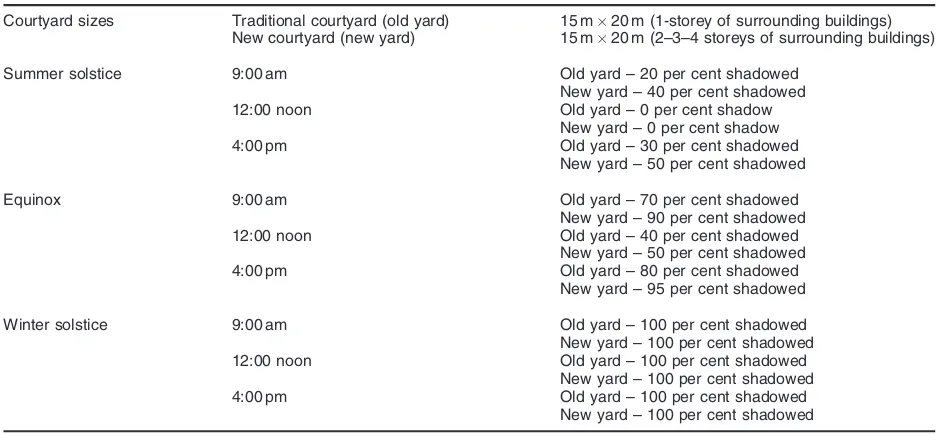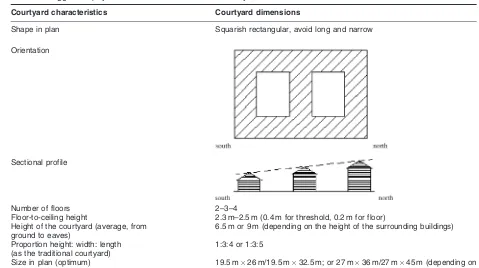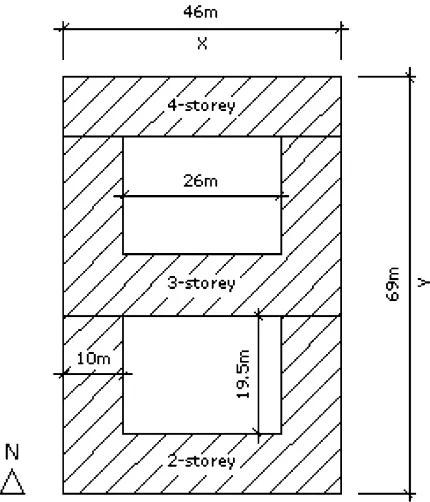New courtyard houses of Beijing: direction of future
housing development
Donia Zhang*
Department of Architecture, School of the Built Environment, Oxford Brookes University, Headington, Oxford OX3 0BP, UK
The aim of this study is to evaluate the physical form of the phase one new courtyard housing prototype in Juer Hutong (‘Chrysanthemum Lane’) of Beijing, and propose further design development for the new courtyard type. In doing so, Heliodon experiments were carried out, using architectural simulation models, to test sunlight penetration during different times of the day and different times of the year, to find the optimum courtyard proportion of plan form and building height. Furthermore, two architectural models of different courtyard sizes were created and studied, to compare their density value and plot ratio. Comparative studies were also made of four different housing types built in Beijing since 1949. The results show that the new courtyard housing type not only achieves high density, but also provides more meaningful residential lifestyle when looked at from social, cultural, architectural, environmental, and historical perspectives.
URBAN DESIGNInternational(2006)11,133–150. doi:10.1057/palgrave.udi.9000173
Keywords: courtyard housing; courtyard design; vernacular architecture; urban renewal; sustainable urban form
Introduction
People need green spaces. They want to feel in touch with nature and away from the ‘hustle and bustle.’ Beijing has a number of city parks, and at least one is located in each urban district. They are peaceful refuges from the toughness of a working life, sanctuaries for the enjoyment of the art of landscape; they are the places for family recrea-tion in the weekends, but too far for the majority of people to reach daily. Green areas are created here and there in the city; they sit mostly along the middle of two traffic roads and have a few dozen trees, which function only as decorations to the street scene rather than as places for people to enjoy their shade.
Children need areas for play. Alexander et al (1977) argued that ‘If children don’t play enough with other children during the first 5 years of life,
there is a great chance that they will have some kind of mental illness later in their lives’ (p. 342). They further affirmed that adults need areas for sport; the human body wears down when it is not used. ‘There is ample empirical evidence that physical health depends on daily physical activ-ity’ (p. 364). And the elderly need areas for morning exercises such as Tai-chi, to maintain physical and psychological well-being. But where can they find these spaces?
The New Courtyard Houses of Beijing seem to be the most appropriate solution. People can be freed from the previously incrementally over devel-oped old courtyard houses or the isolated new apartments, and immediately enter a piece of green land with trees, water, and flowers, beauti-fully designed and arranged. Balconies and gallery corridors can be built on the upper levels for viewing the scenery inside the courtyard (Figures 1 and 2).
The essence of the courtyard house lies in its definition of an interior landscaped realm. Its form suggests an inward, closed world, separated
*Corresponding author: Donia Zhang, Department of Architecture, School of the Built Environment, Oxford Brookes University, Headington, Oxford OX3 0BP, UK
from the street. The symbolism of the courtyard is an illusion of an infinite space, an impression enhanced by its isolation. Its myth of the hollow form embodies an ‘Island of the Blessed,’ and approximates to the archetype of the mother, who is a symbol of femininity (Blaser, 1985). The courtyard offers air, light, and seclusion. It provides the desired privacy and peace, making the environment an oasis of tranquillity, at the same time as if creates a strong sense of territory.
The courtyard is also a place for contemplation. Humans are not only rational beings, they are also contemplative (Polyzoideset al, 1992). We think of
contemplation as a religious exercise, as prayer in church or monastery, or perhaps as quiet medita-tion in a park or garden. But the basic unit of human activity for most people, and for society as a whole, is the family (Chermayeff and Alexan-der, 1963). The traditional courtyard house of China was for one family. Therefore, a courtyard house can be a very convenient location for contemplation to take place.
The Chinese have been living in their traditional courtyard houses for thousands of years (Figures 3 and 4). The earliest type of courtyard house in China dates from 3000 BC (Blaser, 1985). Beijing Figure 1. Juer Hutong new courtyard housing, Beijing.
has been the capital of China for the last 800 years. This imperial city has a unique pattern of courtyard housing embedded in its urban fabric, and the traditional courtyard house was theonly architectural form in Beijing for centuries (Chat-field-Taylor, 1981).
The classical courtyard houses have many ad-vantages in the creation of a pleasant living environment, such as allowing more sunlight penetration and natural ventilation than the residential tower blocks, and providing a green space for the family and social gatherings. These
aspects meet our current search for a sustainable urban form.
In a contemporary discourse on sustainability, Chawla (2002), Lyle (1993), and Orr (2002) called for an ‘ecological design.’ Farmer and Guy (1999) argued that one of the ways to achieve environ-mental sustainability is through the use of natural ventilation to reduce energy consumption. Brundtland (2005) belied that only if we solve ‘social and economic problems can we solve environmental problems.’ Through his study, Khattab (2002) gained ‘important lessons about Figure 3. Aerial view of well-preserved traditional courtyard housing in Beijing.
the mutual interaction between culture and architecture, and the effect that each has on the other’ (p. 1). Hargreaves and Webster (2000) also stressed the importance of social and cultural sustainability for existing communities. Capra (1994) contended, ‘The central challenge of our time is to create and maintain sustainable com-munities, that is social, cultural, and physical environments in which we can satisfy our needs and aspirations without diminishing the chances of future generations’ (p. 1). Wheelwright (2004) considered that sustainability describes a ‘cultural practice’ which is still very much in the making, because according to Merchant (1990), culture is dynamic and primary, whereas nature is passive and secondary – ‘nature is simply the space wherein cultural change takes place.’ Wheel-wright further argued that ‘this identity crisis underlies all environmental thinking and suggests that the issue of the environment and the place of sustainability is fundamentally a cultural problem not a natural one’ (p. 3). In Wheelwright’s view, architecture can bridge the natural–cultur-al divide since architecture is culturnatural–cultur-ally con-ceived, earth-changing artifacts stuck in the ground in the wind, rain, and sun. As such, architecture is viewed interdisciplinary which draws as much from the social sciences as the natural sciences. Sustainability is about remem-bering where we come from and rethinking architecture at its roots.
Over the last few decades, the traditional court-yard houses of Beijing have been experiencing rapid deterioration, and there have been heated debates, nationally and internationally, as to whether Beijing should demolish or preserve them. The traditional courtyard housing type was the product of particular historical situations; it no longer properly serves modern living requirements. The decline of the courtyard, the appearance of the yard,’ or even ‘chaotic-no-yard’ in the Old City of Beijing has proved this (Figures 5 and 6). Also, it would be impractical to rebuild these one-storey courtyard houses with the aim of accommodating housing needs of everyone. The total population of China has tripled since 1949, according to the 2000 census.
There have been a number of research studies on neighbourhood renewal in the Old City of Beijing (eg Wu, 1992, 1994, 1999; He, 1993; Lu¨, 1993; Broudehoux, 1994; Tan, 1994, 1996; Zheng, 1995; Li, 1998; Han, 2001; Zhang et al, 2003; Hu, 2004).
However, no study of an optimum new courtyard form, based on the traditional courtyard proportions, no density comparison of different courtyard sizes and of different housing types in Beijing has been found (Zhang, 1994). Thus this research has attempted to fill this knowledge gap.
The Juer Hutong1(‘Chrysanthemum Lane’) new courtyard housing phase one experiment won six awards, including theWorld Habit Award in 1992 (Wu, 1999). This prototype, the first of its kind, was completed in 1990 on an existing old courtyard housing site. The method is to demolish old, deteriorated, one-storey courtyard houses, to trace their original layout on site, and to build 2– 3-storey new apartment blocks around the court-yard, aiming to improve the physical environ-ments of those particular neighbourhoods, and meanwhile to contribute to the formulation of rehabilitation strategies for this historical area as a whole through planning and design as well as onsite experiments (Figure 7). In this strategy, the old trees are preserved, still providing shade in summer for the local residents who continuously tell tales about the old courtyard to the new generations. The integration of the house with the site is then maintained due to the compatibility between the new courtyard houses and the old courtyard system in the city. It was hoped that by re-accommodation on site, the original neighbourhood community structure would be maintained (Wu, 1992).
Led by Professor Wu Liangyong, the research team at the Institute of Architectural and Urban Studies of Tsinghua University of Beijing de-signed the Juer Hutong new courtyard housing prototype. These new courtyard houses exemplify the crucial order and social structure which existed in Beijing, and which many urban design efforts currently lack. It demonstrates, through phased remodelling (Figure 8) and rehabilitation, that the originality of the traditional courtyard house with its distinct local features can still be maintained while living conditions have been improved.
The concept and realization of the new courtyard house is powerful and successful. It not only achieves high density, but also has the capacity for communal facility provision and good privacy
1The word hutong, for ‘lane,’ was derived from the word
and security control. The courtyard creates a comfortable outdoor environment for the local residents, which is essential for the 21st century modern living.
However, after having studied the phase one experiment model, it becomes obvious that some adjustments to the design of the new courtyard house are required. The purpose of this research is to evaluate the physical form of the phase one new courtyard housing prototype in Juer Hutong (‘Lane’) of Beijing, and propose further design development for the new courtyard type.
Discussion
A key feature of the new Juer Hutong is the use of the courtyard: two large ones and two small ones shared by 46 households. Why are they different in size? Wu (1999) revealed that in order to raise the floor-area ratio,2 the research team had to Figure 5. Deteriorated courtyard housing in Beijing.
Figure 6. Deteriorated courtyard housing in Beijing.
2Floor-area ratio is defined as the amount of floor area built
reduce the courtyard size during the design process. After seeing the phase one experiment model, my immediate questions were, ‘Are both the large and small courtyards working? How large should the courtyard be so as to make it work environmentally and climatically?’ Marcus and Sarkissian (1986) maintained that if the courtyard space is too narrow, it may generate a feeling of privacy invasion for the residents whose windows face each other. It will also probably be over-shadowed for most of the time during the year. Too much space can be as much a problem as too little. Neighbours on opposite sides of this area will probably never get to meet each other.
Juer Hutong phase 1 Heliodon3experiment
To test the performance of the new courtyards in Juer Hutong phase one experiment, an architec-tural simulation model was made at 1:500 scale (Figure 9) and a Heliodon experiment was carried out in a laboratory at Oxford Brookes University, aiming to examine the shadow movement inside the courtyards during different times of the year and different times of the day, so as to draw a Figure 7. Aerial view of the new courtyard housing in Juer Hutong. Photo by Y. Chen.
Figure 8. Juer Hutong site model of phase 1, 2, and 3 experiments. Photo by Y. Chen.
3Heliodon: A mechanical device, used in architecture, for
demonstrating the sun’s motion relative to a building.Source:
tentative conclusion about the optimum court-yard form. Data were recorded during this experiment (Table 1).
Analysis of data
Despite the size of the courtyards, 12:00 noon of the summer solstice is the only time of the year that the courtyards are not affected by over-shadowing. The small courtyards in this proto-type do not seem to work; they are always overshadowed at all times of the day all year round. This finding confirmed the post-occu-pancy evaluation by the residents living in the ground floor apartments around the small court-yards (see Wu, 1999). In the winter solstice, at all times, the large courtyards are also totally over-shadowed. At this stage, it would be interesting to compare how overshadowing affected the tradi-tional courtyard, surrounded by one-storey build-ings, with its new adaptation, surrounded by 2–3-storey buildings with the same courtyard dimen-sions in plan.
Comparative Heliodon experiment
Two more architectural simulation models were made at 1:500 scale (Figure 10) for this compara-tive Heliodon experiment. Assuming that the new
courtyard houses are built exactly to the same layout as the traditional ones, with the same courtyard dimensions in plan, data were recorded during the second experiment (Table 2).
Analysis of data
Despite the height of the surrounding buildings, 12:00 noon of the summer solstice is the only time of the year when the courtyards are not affected by overshadowing. In the winter solstice, at all times, both the traditional and the new courtyards are always totally overshadowed. Overall, the new courtyards are more overshadowed than the traditional ones, because of the increase in the height of the surrounding buildings.
Arguably, the shadow projected onto the trees inside the courtyards helps to create an interest-ing silhouette reflected onto the internal court-yard walls. The shadow is also the protection against Beijing’s hot summer sun. One may debate how much shadow is desirable, but it is important to achieve a healthy balance between light and shadow.
building forms in reality, such as the balconies and terraces that alter building depth and height in various parts and thus may help to increase or decrease the sunlight penetration in some areas of the courtyards.
Courtyard form
Assuming that the amount of sunlight penetration in the traditional courtyard is time-tested and is thus desirable to achieve, the new courtyard Table 1 Data of the Juer Hutong Phase 1 Heliodon experiment
Courtyard sizes Big yard 15 m13 m (12 m10 m in green grass)
Small yard 7.5 m6.5 m (6 m5 m in green grass)
Summer solstice 9:00 am Big yard – 40 per cent shadowed
Small yard – 100 per cent shadowed
12:00 noon Big yard – 0 per cent shadow
Small yard – 0 per cent shadow
4:00 pm Big yard – 75 per cent shadowed
Small yard – 100 per cent shadowed
Equinox 9:00 am Big yard – 95 per cent shadowed
Small yard – 100 per cent shadowed
12:00 noon Big yard – 40 per cent shadowed
Small yard – 100 per cent shadowed
4:00 pm Big yard – 100 per cent shadowed
Small yard – 100 per cent shadowed
Winter solstice 9:00 am Big yard – 100 per cent shadowed
Small yard – 100 per cent shadowed
12:00 noon Big yard – 100 per cent shadowed
Small yard – 100 per cent shadowed
4:00 pm Big yard – 100 per cent shadowed
Small yard – 100 per cent shadowed
dimensions in plan have to be increased to achieve the proportions of the traditional court-yard (Tables 3 and 4).
In terms of the balance between density and building height, Alexander et al (1977) have rightly and explicitly stated: ‘In any urban area, no matter how dense, keep the majority of buildings four storeys high or less. It is possible that certain buildings should exceed this limit, but they should never be buildings for human habitation’ (p. 119). In fact, most of the old residential quarters of Beijing are within the 9-metre height control zone established by the municipal government. Four storeys is the highest limit for a building in these areas.
Density comparison
If the courtyard area is enlarged and the building depth remains, the plot area will increase, and the density may decrease. The argument would be: if a ‘little drop’ in density can be traded off by a larger, but climatically better performing court-yard, then this ‘drop’ will be worthwhile. To investigate the density variation due to the increase in courtyard dimensions in plan, it is necessary to establish two models to represent the new courtyard house type, with different court-yard sizes (Figures 11 and 12). The method is to
use the traditional courtyard proportion as the basic criteria (Table 3).
In the above two models, Model A has two courtyards of 20 m15 m each, and Model B has
two courtyards of 26 m19.5 m each; the building
depth is 10 m in both cases. Assuming that each apartment unit is 60 m2 with 2-bedrooms (con-cluded from Juer Hutong phase one experiment), and each bedroom is occupied by two persons, the density value and plot ratio of the two proposed models were calculated (Table 5).
Analysis of data
The increase in courtyard dimensions in plan which resulted in the increase in plot area willnot significantly affect the absolute density value because of the increase in number of households, which leads to the increase in number of persons in the courtyard neighbourhood. The above two models A and B have a density of 670 persons/ha and 657 persons/ha, respectively.
Table 2 Data of the Juer Hutong comparative Heliodon experiment
Courtyard sizes Traditional courtyard (old yard) 15 m20 m (1-storey of surrounding buildings)
New courtyard (new yard) 15 m20 m (2–3–4 storeys of surrounding buildings)
Summer solstice 9:00 am Old yard – 20 per cent shadowed
New yard – 40 per cent shadowed
12:00 noon Old yard – 0 per cent shadow
New yard – 0 per cent shadow
4:00 pm Old yard – 30 per cent shadowed
New yard – 50 per cent shadowed
Equinox 9:00 am Old yard – 70 per cent shadowed
New yard – 90 per cent shadowed
12:00 noon Old yard – 40 per cent shadowed
New yard – 50 per cent shadowed
4:00 pm Old yard – 80 per cent shadowed
New yard – 95 per cent shadowed
Winter solstice 9:00 am Old yard – 100 per cent shadowed
New yard – 100 per cent shadowed
12:00 noon Old yard – 100 per cent shadowed
New yard – 100 per cent shadowed
4:00 pm Old yard – 100 per cent shadowed
New yard – 100 per cent shadowed
Table 3 Courtyard proportions
Height Width Length
1 3 4
Traditional courtyard 5 m 15 m 20 m
New courtyard 6.5 m 15 m 20 m
This discovery indicates that the new courtyard housing type not only achieves a relatively high density compared with three other housing types constructed in Beijing since 1949 (Table 6), but also has more potential developmental advan-tages when looked at from social, cultural, architectural, environmental, and historical per-spectives.
This result confirmed the findings on land use forms conducted by the Martin Centre of Archi-tectural and Urban Studies at Cambridge Uni-versity that, using the same area of land, the courtyard form (or perimeter block) is the most economical in terms of land use (Martin and March, 1972). It also echoed what Tsinghua University research team found: it is possible to achieve a high floor-area ratio with a 2–3-storey courtyard building form, even in this 9-metre height restricted zone (Wu, 1999, p. 124).
The limitations when applying this abstract theoretical model to the specific local conditions are that the existing layout of the old courtyard houses may not permit the increase in the new courtyard size if the method of building the new courtyard houses is to ‘trace their original layout Table 4 Suggested physical dimensions for the new courtyard
Courtyard characteristics Courtyard dimensions
Shape in plan Squarish rectangular, avoid long and narrow
Orientation
Sectional profile
Number of floors 2–3–4
Floor-to-ceiling height 2.3 m–2.5 m (0.4 m for threshold, 0.2 m for floor) Height of the courtyard (average, from
ground to eaves)
6.5 m or 9 m (depending on the height of the surrounding buildings)
Proportion height: width: length (as the traditional courtyard)
1:3:4 or 1:3:5
Size in plan (optimum) 19.5 m26 m/19.5 m32.5 m; or 27 m36 m/27 m45 m (depending on
the height of the surrounding buildings)
on site.’ The existing infrastructure and street/ lane patterns may also present problems in the new courtyard achieving its optimal dimensions. However, this theoretical model could be applied in other new housing development areas of Beijing and other cities in China.
The research findings may help the Beijing Municipal Planning Bureau, Beijing Municipal Housing Reform Office, and other related institu-tions to re-evaluate the benefits of this new courtyard housing type, and to make informed decisions about completing the phases 3 and 4 of the Juer Hutong project; its master planning has been completed, but construction work has been banned since 1994. It may also re-awaken aca-demic interests in conducting more research on the new courtyard housing type. It is my sincere hope (and may be my utopian dream) that, these new courtyard houses will be built all over the City of Beijing in the foreseeable future.
Recommendations
I visited the new courtyard housing neighbour-hood in Juer Hutong of Beijing in 1995 and
observed that the courtyard was, indeed, a peaceful and quiet place. However, it was not used as much as it should be. There was hardly any resident inside the courtyard while I was there (3:00–4:00 pm during a week day in March), and there was no recreational facilities provided in the courtyard either. The space was randomly parked with bicycles and hung with washed clothes. It was disappointing. This made me ponder about better design for the courtyard neighbourhood environment so as to maximally facilitate social interaction, a capability that is manifested in its physical form.
Courtyard design
The courtyard as a space, its landscape design should be treated as an integral part of the overall site design rather than as some place ‘purposely left open with a few trees.’ Several housing evaluation studies in the West show that the exterior appearance of individual dwellings mat-ters less to residents than the layout and land-scape of the scheme as a whole (Marcus and Sarkissian, 1986). To fulfil the command of the courtyard as an ‘outdoor parlour for recreation’ and the ‘communal living room,’ more work should be carried out on the design of the courtyard, with hard and soft landscape, so that it will generate a substantial variety of places and multiply the possibilities of diverse experiences within the dwellings.
Figure 12. Model B: after enlargement.Note: Diagrams
showing the increase in courtyard dimensions in plan (according to the traditional courtyard proportion: 1:3:4) for a climatically better performing courtyard.
Table 5 Density value and plot ratio calculations
Model A Model B
Built floor areas ‘A’: Built floor areas ‘A’: A1¼1400 m2(2-storey areas) A1¼1700 m2(2-storey areas)
A2¼2100 m2(3-storey areas) A2¼2550 m2(3-storey areas)
A3¼1600 m2(4-storey areas) A3¼1840 m2(4-storey areas)
A¼5100 m2(total) A¼6090 m2(total)
Number of households: Number of households: N¼Total area/unit area N¼Total area/unit area
¼5100/60¼85 ¼6090/60¼101.5
Number of persons: Number of persons:
Persons¼340 Persons¼406
Site area¼XY¼2400 m2 Site area¼XY¼3174 m2
Plot area¼5074 m2 Plot area¼6175 m2
Density¼No. of persons
in block/plot area (hectare)
Plot ratio¼Site area/built
floor area
Model A Model B
Density¼670 persons/ha Density¼657 persons/ha
Table 6 Comparison of the four different housing types built in Beijing since 1949 used only for bike parking of each floor as the threshold used only for bike parking of each floor as the threshold skyline of the city and creating visual
Note: Household usually comprises 1–3 bedrooms and a hall-room/living and dining room.
Artistic approach
The richness in the design of the classical Chinese gardens in Suzhou and Hangzhou can be the primary source of inspiration for the design of the new courtyard houses in Beijing to beautify the living environments, as well as to enhance China’s cultural identity. Is it possible for the new courtyard house to combine both the sense of order of the traditional Chinese courtyard house and the sense of organism in the traditional Chinese garden (Figures 13 and 14) to create more pleasing living environments?
Art, as well as architecture, is not self-contained or independent, but about things outside itself: politics, ideas, morals, emotions, institutions, and history. Art has meaning, it is related to the great world outside art narrowly defined, and it lends support to high moral principles, affects urban layout, the external appearance of buildings, and their interior plans. Art seems to possess the capacity to elevate both taste and morals. To adorn a city with works of art is to uplift its inhabitants, to educate people through their eyes, form their taste, polish their manners, and elevate their soul (Olsen, 1986).
Figure 13. Wang Shi Yuan (Master-of-Nets Garden), Suzhou.
Functional approach
People need self-expression and exchange. A city is a place of exchange, not only of information, friendship, culture, knowledge, but also emo-tional and spiritual exchange (Engwicht, 1992). The courtyard as a basic unit of the city should be capable of providing the opportunities for this exchange to occur. Communal areas, such as a library, study room, meeting room, leisure centre, kindergarten, swimming pool, laundry, work-shops, gym, public seating, and so on if provided within a courtyard compound, will help facilitate this social exchange. To provide this, special consideration should be given to the people who have reached different stages in life: the children, the teenagers, the adults, the elderly, and the disabled, all needing different facility provision. All these spaces should be arranged on the ground floor around the courtyard. These public services have not been integrated into the Juer Hutong new courtyard housing prototype, but should be in future housing renewal projects.
Special occasions
Chinese culture has undergone a sophisticated development process throughout its 5000-year written history. Some traditional festivals, such as the ‘Spring Festival’ and the ‘Mid-Autumn Festi-val,’ should be respected and taken into full consideration when designing the new courtyard house, to enhance China’s cultural continuity. These festivals can become good opportunities for residents to become acquainted with others in the neighbourhood. The courtyard should be furn-ished with adequate seating, tables, and decora-tions for these special occasions, even if temporarily.
Housing is clearly more than ‘a roof over one’s head.’ It is crucial for the design team to regard these amenities as an essential part of community design, to enhance all aspects of urban life in the new courtyard housing environment.
Urban design
The unique lifestyle of Beijing lies in the tradition embedded in its everyday living. Coming from such a place, I always hold a fond memory of the morning breakfast there: a bowl of Soya-bean milk, together with a steamed (or fried) bun stuffed with sweetened red bean paste,ora baked
wheaten cake mixed with sesame paste. Davies (1981) also observed that ‘knots of workers prop their bikes up and gather at the sales-windows of snack-shops, paying a few cents for a bowl of Soya-bean milk and a few deep-fried, twisted dough-sticks. Not everyone has time to prepare breakfast at home.’ It is a pity that this kind of traditional living is disappearing in Beijing due to ‘modernization.’ Therefore, it is vital for the urban designers to save Chinese tradition, perhaps by designing a place like a teahouse at the corner of each urban block, with some outdoor seating, serving simple food and drinks (Figure 15). When these facilities are present, this offers something special to the lives of people who use them. The teahouse can also become a local landmark that helps to create ‘a sense of place.’
In many European cities and towns, there is a street cafe´ in every urban block. Such a place provides social glue for the community and helps to increase neighbourhood identity (Figure 16). It is one of the few settings where a newcomer can start meeting people who have lived nearby for many years (Alexanderet al, 1977).
Maintenance and management
Beijing is in its infancy of a housing reform: from a state housing allocation system to a socialist market economic one. But the mechanism is far from having reached maturity. As Wu (1999) noted, the newly established Housing Cooperative did not take over responsibility for service, property management, or maintenance in the neighbour-hood; there were many post-occupancy problems. Wu asserted that an effective means for resident participation and management has yet to be found. Marcus and Sarkissian (1986) discovered that good maintenance is closely correlated with overall resident satisfaction, especially the main-tenance of communal open space. Native species, such as pine, plum blossom, red cedar, jujube, pomegranate, yulan magnolia, Chinese flowering crab-apple, crape myrtle, Chinese wisteria, and lilac, minimize maintenance, and existing trees should be retained, and, if possible local residents employed in maintenance work. An adequate operating budget is needed to maintain the proposed landscape. Where financially and so-cially appropriate, cooperative ownership could be encouraged. Where residents pay a specific maintenance fee, all households should have equal visual and functional accessibility to the facilities they are paying for.
Marcus and Sarkissian (1986) further indicated that good management is essential to the success of any multifamily housing development. Local,
decentralized, responsive, and flexible manage-ment structure is more efficient than large, impersonal, centralized bureaucracies. Design can facilitate or inhibit good management. Design should take account of project management and repair policies. Designers and management team should prepare a manual, in which tenant responsibilities on site should be clearly spelled out. Locate the management office at a central visible point. Ensure access to the office by both occupants and outsiders. Consider increasing the amount of resident participation in management. The greater the level of responsibility assigned to each inhabitant, the easier will be the task of management (Figures 17 and 18).
The experience of the Juer Hutong new courtyard housing rehabilitation project shows that urban renewal in the Old City of Beijing is a very complicated issue and a daunting task, both from the socio-economic and technical points of view. A multi-disciplinary approach to housing regen-eration is necessary, requiring a high degree of collaboration between architects, urban designers, city planners, and local residents (Wu, 1994). These efforts are worthwhile; because vernacular architecture is so deeply rooted in local life, then it must have an intrinsic value for survival and revival. As Rapoport (1983) maintained, since many human activities and behaviour have not changed much since the beginning of humanity, so the small units of settlement pattern as exemplified by the traditional housing type may
be more satisfactory than the newer ones. In this sense, the new courtyard housing type, the contemporary adaptation of the traditional one, may have a more sustainable future.
This research is purely an academic study. In reality, there are many practical matters to be dealt with during the rehabilitation process, such as building infrastructure for gas, water, and electricity supplies; installing storage boilers for
central heating systems, setting up sewage drai-nage lines, and obtaining funds and subsidies to guarantee that a certain number of original residents return to the redeveloped neighbour-hood, and so on. Thus this research has only touched upon ‘a tip of an iceberg.’
Further research will be warranted into standar-dization of the new courtyard system to reduce the design and construction cost; the evaluation of Figure 18. Renovated hutong (‘lane’) in Beijing.
the layout and structure of the urban block; and ways to promote resident participation in post-occupancy maintenance and management (Wu, 1994, 1999). Any development in human history seems to have followed a spiral improvement process. Housing is no exception. The poet T.S. Eliot (1968) has well concluded in three lines:
Time present and time past
Are both perhaps present in time future And time future contained in time past.
Acknowledgements
My gratitude goes to Professor Richard Hayward, for his kind, consistent encouragement and invaluable suggestions. He supervised my MA dissertation in Urban Design at Oxford Brookes University and is at present Head of School of Architecture and Construction at University of Greenwich, London. I am also thankful to Mrs. Margaret Ackrill at Oxford Brookes University who proofread this publication paper.
References
Alexander, C., Ishikawa, S., Silverstein, M., Jacobson, M., Fiksdahl-king, I. and Angel, S. (1977)A Pattern Language. New York: Oxford University Press. Blaser, W. (1985) Atrium: Five Thousand Years of Open
Courtyards. New York: Wepf and Co. AG, Basel. Broudehoux, A.-M. (1994) Neighborhood regeneration
in Beijing: an overview of projects implemented in the inner city since 1990, Master of Architecture Thesis, School of Architecture, McGill University, Montreal, Canada.
Brundtland, G. (2005) Brundtland Lectures on Sustain-ability [Corporate Social Responsibility] Institute of Environmental Management and Assessment. Re-trieved October 29, 2006 from: http://www.iema.-net/news/envnews?aid¼5123.
Capra, F. (1994) Ecology and Community. Berkeley, CA: Center for Ecoliteracy.
Chatfield-Taylor, A. (1981) Vernacular architecture and historic preservation in modern China, Ekistics, 48(288): 199–201.
Chawla, L. (2002) Cities for human development, in Chawla, L. (ed.)Growing Up in an Urbanizing World. London, UK: UNESCO/Earthscan Publications, pp. 15–34.
Chermayeff, S. and Alexander, C. (1963)Community and Privacy: Towards a New Architecture of Humanism. Middlesex, England: Penguin Books.
Davies, S. (1981)A Guide to Peking. Hong Kong: China Guides Series.
Eliot, T.S. (1968) Burnt Norton: Four Quartets. London: Folio Book.
Engwicht, D. (1992) Towards an Eco-city: Calming the Traffic. Sydney, Australia: Envirobook.
Farmer, G. and Guy, S. (1999) Visions of Ventilation: Pathways to Sustainable Architecture. UK: Depart-ment of Architecture, University of Newcastle upon Tyne.
Han, B. (2001) Reweaving the Fabric: A Theoretical Framework for the Study of the Social and Spatial Networks in the Traditional Neighbourhoods in Beijing, China. USA: Georgia Institute of Technology. Hargreaves, A. and Webster, R. (2000) Social
sustain-ability and local distinctiveness: arguments for the positive evaluation of place centered awareness, Paper presented at the ENHR 2000 Conference, 26– 30 June 2000, Gavle.
He, H. (1993) Social and economic aspects of Beijing old-city redevelopment programs, Building in China,6(3–4): 16–23.
Hu, X. (2004) Contemporary regionalism in Chinese architecture: A perspective inspired by K. Framp-ton’s critical regionalism (From 1980 to the pre-sent), Master of Science in Architecture Thesis, School of Architecture and Construction Manage-ment, Washington State University, USA.
Khattab, O. (2002) Reconstruction of traditional archi-tecture: a design education tool, Global Built Environment Review,2(2): 29–39.
Li, T. (1998) Residential renewal in old Chinese cities since 1979: Under the transition from central-planned to market-driven economy, Master of Urban and Regional Planning Thesis, Faculty of the Virginia Polytechnic Institute and State Uni-versity, Blacksburg, Virginia, USA.
Lu¨, J. (1993) Beijing’s old and dilapidated housing renewal (phase 1), Building in China, 6(3–4): 24–35.
Lyle, J.T. (1993) Urban ecosystems: cities of the future will embrace the ecology of the landscape, rather than set themselves apart,Designing A Sustainable Future,35: 43.
Marcus, C. and Sarkissian, W. (1986)Housing as if People Mattered. Berkeley: University of California Press. Martin, J.L. and March, L. (1972) Urban Space and
Structures. Cambridge, UK: Cambridge University Press.
Merchant, C. (1990) The Death of Nature: Women, Ecology and the Scientific Revolution. New York: HarperSanFrancisco, an imprint of HarperCollins Publishers.
Olsen, D. (1986)The City as a Work of Art: London, Paris, Vienna. London, Yale University Press.
Orr, D.W. (2002)The Nature of Design: Ecology, Culture, and Human Intention. New York: Oxford University Press.
Polyzoides, S., Sherwood, R. and Tice, J. (1992) Courtyard Housing in Los Angeles: A Typological Analysis, 2nd edn. New York: Princeton Architec-tural Press.
Rapoport, A. (1983) Environmental quality: metropoli-tan areas and traditional settlements, Habitat International,7(3/4): 37–63.
Tan, Y. (1996) Relocation and the People: A Research on Neighbourhood Renewal in the Old City of Beijing. Beijing: Department of Urban Planning and De-sign, Tsinghua University School of Architecture. Wheelwright, P. (2004) The problem of sustainability: A
response (Response to Molecules, Money, and De-sign by Mark Jarzombek, published in Thresholds 20, MIT Journal, Fall 2000). Retrieved August 4, 2004 from: http://www.pmwarchitects.com/ ac_tech.htm.
Wu, L. (1992) Rehabilitation in Beijing,Habitat Interna-tional,15(3): 51–66.
Wu, L. (1994) The future direction of the experiments, Beijing Ju’er Hutong New Courtyard Housing Experi-ment. Beijing, China: Institute of Architectural and Urban Studies, Tsinghua University.
Wu, L. (1999) Rehabilitating the Old City of Beijing: A Project in the Ju’er Hutong Neighbourhood. Vancou-ver, BC: University of British Columbia Press. Zhang, D. (1994) New courtyard houses of Beijing:
Direction of future housing development, Unpub-lished Master of Arts in Urban Design Thesis, Joint Centre for Urban Design, School of Architecture, Oxford Brookes University, Oxford, UK.
Zhang, Q., Wang, J., Gong, P. and Shi, P. (2003)Study of Urban Spatial Patterns From SPOT Panchromatic
Imagery Using Textural Analysis. London, Ontario, Canada: Department of Geography, University of Western Ontario.
Zheng, J. (2005) Rescue Hutong (text in Chinese),Ming Bao (‘Brightness Newspaper’) Saturday Supplement, 504: 21–30.
Zheng, L. (1995) Urban renewal in Beijing: Observation and analysis, Master of Architecture Thesis, School of Architecture, McGill University, Montreal, Canada.
About the author
Donia Zhang is currently doing a PhD in
